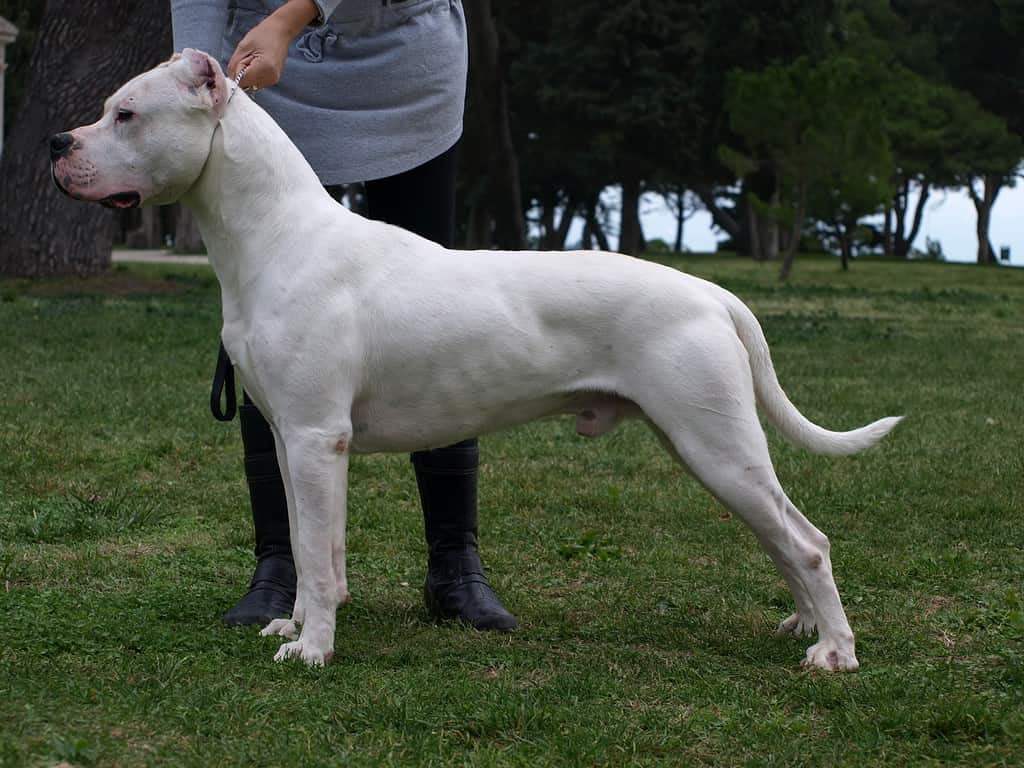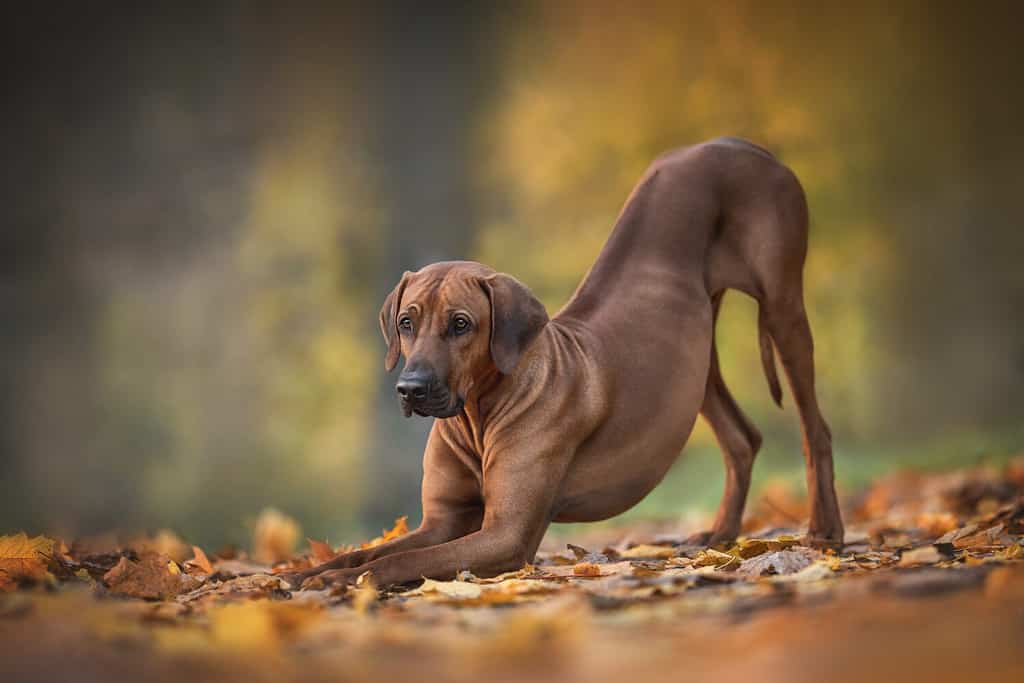The Dogo Argentino and Rhodesian Ridgeback were bred for similar purposes, leading to them being fairly similar dogs. For instance, they are both relatively active and have very strong prey drives.
That said, they also have many differences. Just because one breed may work for your family doesn’t mean the other one will. In this article, we’ll explain some of the most important differences.
1. Dogo Argentino vs. Rhodesian Ridgeback: Origin

Dogos are exceptionally large, which you should keep in mind before purchasing one.
The Dogo Argentino is from Argentina, hence their name. They weren’t developed until the early 20th century, so they’re a relatively new breed. Their creation aimed to produce a large, powerful dog capable of hunting larger game, like wild boar and puma. Many larger dogs, including the Great Dane, were utilized to achieve this.
We know a lot about how the Dogo Argentinos came to be, as their creation process was carefully documented.
The Rhodesian Ridgeback comes from Southern Africa – the other side of the world. They originally came from Rhodesia, which is now called Zimbabwe. However, they were developed by European settlers to create a versatile hunting dog that could withstand the African terrain. The result was the Rhodesian Ridgeback, which can track and take on large game, like lions.
Both of these dogs were bred for large game hunting – but on opposite sides of the planet.
2. Dogo Argentino vs. Rhodesian Ridgeback: Appearance

While Rhodesian Ridgebacks dogs can get pretty large, they are smaller than Dogos.
©Eric Isselee/Shutterstock.com
Dogo Argentinos are very large, muscular dogs. They typically weigh between 80-100 pounds. Their robust build helps them take down large prey, and they’re still bred to be pretty large today. In fact, they’re still used for police work and hunting, which makes their large size very sought-after.
Rhodesian Ridgebacks are also very large, though they are slightly smaller than Dogos. Males may weigh up to 90 pounds, which is only slightly smaller. Of course, they were also bred to hunt large game, so being bigger is absolutely necessary.
Dogos are particularly known for their all-white coat. However, some of them do have patches on their sides and stomachs. In fact, patched dogs are less prone to hearing difficulties, so they are becoming more and more popular. They have a very broad head and a strong neck. You can tell that they’re built for power.
Rhodesian Ridgebacks are brown and have a very distinctive ridge on their back that’s formed by the hair growing in the opposite direction. This ridge is the defining characteristic of the breed and necessary for them to be considered ridgebacks.
3. Dogo Argentino vs. Rhodesian Ridgeback: Temperament

Dogos can be much more aggressive than other dogs. Therefore, socialization is particularly essential.
©Hanna Dymytrova-Kaihila/iStock via Getty Images
Despite being bred for similar purposes, these dogs have pretty different temperaments. Therefore, they will rarely work in the same family. Understanding their temperament differences is one of the most important parts of choosing between these two breeds.
Dogo Argentinos are intensely loyal and affectionate. They have protective instincts, so they must be socialized very well. They bond closely with their owners and are generally good with their children when properly socialized. However, they can be wary and reserved with others.
In some cases, this may cause aggression. Therefore, training early to ensure proper control over these dogs is important. Good breeding also matters. Quality breeders will prioritize temperament, helping ensure these dogs aren’t aggressive.
Dogos have very strong personalities, which can make them difficult to train and control. They’re capable of learning many things and are often utilized as versatile working dogs. However, they are not pushovers and require an experienced, strong dog owner. They’re often willful, which can make obedience challenging.
Rhodesian ridgebacks have similar temperament traits, as they were also bred for hunting. However, they are more hound-like than Dogos, which means they tend to be more stubborn. Hounds just weren’t bred for obedience. They were bred for tracking, which is an innate skill. You don’t have to train it, so obedience was never very high on a hound breeder’s agenda.
These canines tend to form strong bonds with their humans. However, they’re pretty aloof with strangers. They aren’t as protective as Dogos, but they can still be aggressive if not properly socialized. Therefore, we highly recommend socializing them well.
4. Dogo Argentinos vs. Rhodesian Ridgebacks: Needs

Rhodesian ridgebacks do need quite a bit of exercise, but not quite as much as the Dogo Argentino.
©Liudmila Bohush/Shutterstock.com
Both of these breeds have very high exercise needs. Dogos really aren’t great for families that are just looking for a “pet” dog. They’re really best for those who want to get them involved in canine sports, like weight-pulling, tracking, or agility. Otherwise, they can become very rambunctious and bored.
These are not dogs that will be happy with a few walks around the block. You should really plan for two or more hours a day of moderate to intense exercise. That can be a lot for even more active families. Barking and destructive chewing on a massive scale are common when these dogs aren’t properly socialized.
Similarly, Rhodesian ridgebacks need a lot of exercise, too. They’re strong, agile athletes, so you should provide them with plenty of exercise opportunities. They do need slightly less exercise as adults, though, and they tend to be much calmer than Dogos after the age of three or so.
However, you should still provide them with an hour or two of exercise each day. They can be good dogs for active families as long as you can provide time for exercise every day.
Both of these breeds also need plenty of exposure to other people and lots of training. Rhodesian ridgebacks are typically easier to socialize with, though they can be somewhat protective towards strangers. They need extensive exposure to nice people. Otherwise, they can be a bit too aggressive.
However, they are typically harder to train. They’re hounds, through and through. Therefore, they have a very strong mind and tend to not be very obedient. Even if they know what you’re saying, they may not actually do it. It takes a lot of consistency and patience to train these dogs.
Dogos tend to be the opposite. They need lots of socialization, as they are naturally overprotective. Your main focus in the early months should be on socialization. We highly recommend group puppy classes, which can provide socialization and early training.
Without careful socialization, this breed can easily become very suspicious, which can lead to biting. Some Dogos become fearful instead of suspicious, which can also lead to aggression and biting.
Dogos can also be extremely energetic as children. They tend to romp and jump around a lot. Therefore, they can send children flying (or vases or adults). Having a 100-pound dog run into your legs at a full sprint isn’t fun. Therefore, socialization inside and around children is important, as well as training that involves plenty of executive functioning.
Generally, we don’t recommend Dogos for those with children. However, Rhodesian ridgebacks can make good family dogs with proper socialization.
5. Dogo Argentino vs. Rhodesian Ridgeback: Legal Liabilities

To the untrained eye, these dogs look a bit like pit bulls. Therefore, they may be more likely to run into legal issues.
©Eve Photography/Shutterstock.com
While Dogo Argentinos are not related to pit bulls, they do vaguely resemble them. Therefore, they may be banned in certain areas, or your homeowner insurance may refuse to insure you.
Rhodesian ridgebacks look more like hounds. Therefore, they’re much less likely to run into these issues. It’s easy to see that these are not pit bulls, but that isn’t necessarily true for Dogos.
The photo featured at the top of this post is ©
Ready to discover the top 10 cutest dog breeds in the entire world?
How about the fastest dogs, the largest dogs and those that are -- quite frankly -- just the kindest dogs on the planet? Each day, AZ Animals sends out lists just like this to our thousands of email subscribers. And the best part? It's FREE. Join today by entering your email below.
Thank you for reading! Have some feedback for us? Contact the AZ Animals editorial team.







